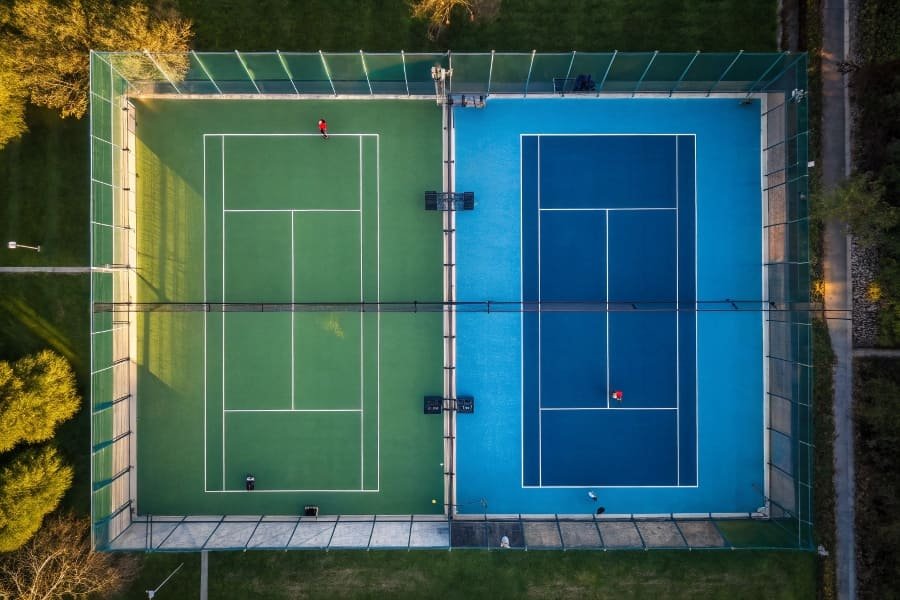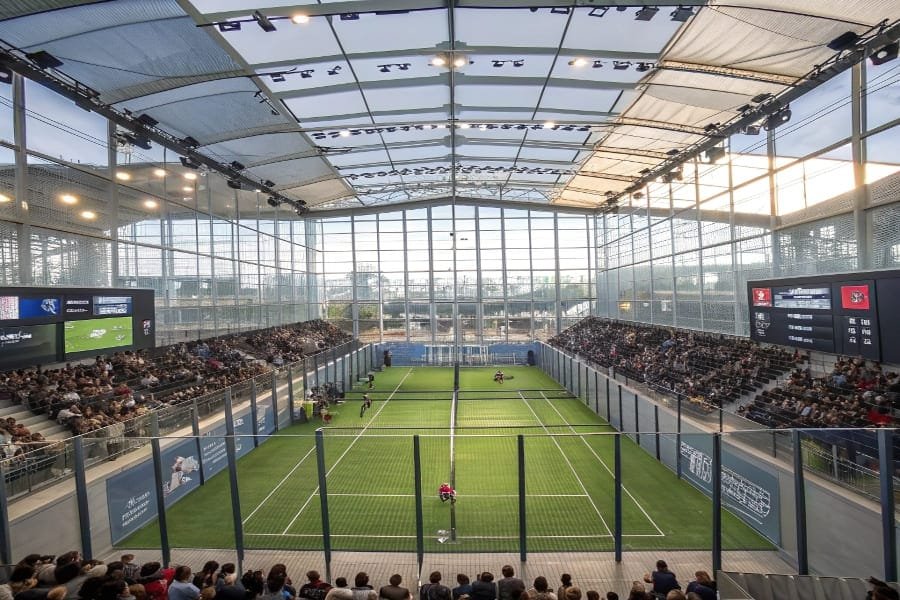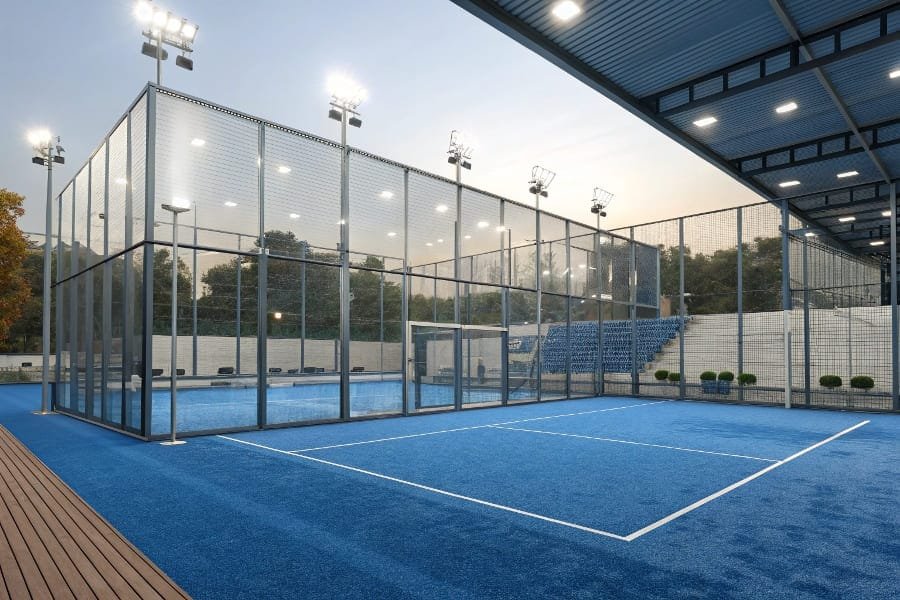When I first heard about padel, I felt confused by how similar it looked to tennis. That confusion sparked my curiosity.
A padel court measures 20m by 10m, and it’s enclosed by walls or glass panels. A tennis court is larger, around 23.77m by 10.97m in singles play, with open boundaries. This difference changes gameplay, strategies, and movement patterns.

padel vs tennis
Padel’s enclosed design encourages creative wall bounces and faster rallies. Next, I will dive deeper into common questions about padel and tennis comparisons. I hope this helps you choose which suits your space, style, or business plans.
Can you play padel in a tennis court?
Many people ask this question. I once tried to adapt a standard tennis court for padel, but I quickly noticed the differences.
You cannot play a proper padel match on a tennis court. The enclosed walls and smaller dimensions are crucial to padel’s gameplay and rules.

padel vs tennis
Dive Deeper: Padel Setup vs. Tennis Setup
Padel depends on walls or glass panels. These structures let the ball bounce, so players can return shots off the walls. Tennis courts do not include any enclosures. They rely on lines to define out-of-bounds. The mismatch of sizes also creates issues. A tennis court is around 23.77 meters long, while a padel court is only 20 meters. That extra length changes how the ball moves, how players position themselves, and how the game flows.
I experienced this first-hand when I tried to create a makeshift padel game on a normal tennis court. We improvised walls using nets, but the ball rebounded in ways that did not match real padel tactics. The net height is another difference. A tennis net is around 0.914 meters in the center for singles. A padel net is about 0.88 meters in the center. Even this slight variation affects shot trajectory. Also, padel usually has doubles teams, so the playing area is designed with four people in mind. A tennis court is flexible for singles or doubles, but its open layout creates a different pace.
| Feature | Tennis Court | Padel Court |
|---|---|---|
| Length | 23.77m (singles) | 20m |
| Width | 10.97m (singles) | 10m |
| Enclosure | No walls | Walls/glass panels |
| Net Height Center | ~0.914m | ~0.88m |
I recommend that people build a dedicated padel court if they want a true padel experience. Adapting a tennis court might seem convenient, but it eliminates the unique walls that define the sport.
What is the difference between padel and real tennis?
I once thought “real tennis” just referred to lawn tennis. I later learned “real tennis” is a centuries-old indoor racket sport. People sometimes compare padel to both modern tennis and real tennis.
Real tennis is played indoors with high walls, sloping roofs, and unique scoring. Padel is an outdoor or indoor game on a smaller court with enclosed glass or solid walls.

padel vs real tennis
Dive Deeper: Unique Heritage and Modern Twist
Real tennis traces back hundreds of years. It uses specialized racquets and balls that can handle rebounds off sloping surfaces known as “penthouses.” This complex environment includes walls, openings, and angled features where the ball can ricochet. I became fascinated by real tennis when I saw how players rely on cunning shots and precise angles. Each real tennis court is slightly different because older buildings do not follow uniform measurements.
Padel is more modern, emerging in the late 20th century. It shares the concept of walls but uses a standardized design. A padel court is always 20 meters by 10 meters. The net is placed in the middle, dividing the court into equal halves. Real tennis courts vary in length, often around 30 meters, though each historical venue might show slight deviations. Real tennis equipment also differs. The rackets are asymmetrical and use tight strings for better control in confined spaces. Padel rackets have perforations across a short, solid face, offering balance between power and spin.
| Sport | Court Environment | Equipment | Key Gameplay Features |
|---|---|---|---|
| Real Tennis | Indoor, with slopes | Asymmetrical racket | Historic rules, varied court designs |
| Padel | Indoor/outdoor enclosed | Solid face racket (holes) | Standardized size, quicker rallies |
The approach to the walls is different. Real tennis walls often include complex angles that can create unpredictable rebounds. Padel walls are typically vertical glass or solid panels designed to keep the ball in play without extreme unpredictability. Learning about these nuances inspired me to appreciate how each variant meets different tastes.
What is the difference between padel and platform tennis?
People outside North America often do not know platform tennis. I learned about it through an American friend who loves winter sports. Now I see the many ways it stands out from padel.
Platform tennis is usually played on an elevated court with tight wire screens. Padel uses glass or solid walls. The rules and racket designs also differ.

padel vs platform tennis
Dive Deeper: Winter-Friendly Origin
Platform tennis began as a cold-weather sport in the US. Its courts are often heated from below to melt ice and snow. The enclosed area uses a strong wire screen around the perimeter, letting the ball bounce back. Padel courts generally do not have heated floors, though some indoor complexes keep the temperature controlled.
I recall my first time observing platform tennis. The platform measured about 6.1 by 13.1 meters, significantly smaller than a padel court. Like padel, doubles is the primary format, but platform tennis encourages faster net play due to the condensed space. Platform tennis rackets are solid paddles with holes, similar to padel rackets, but the ball and bounce can feel different. The net in platform tennis is slightly higher, around 0.91 meters at center, which is close to a tennis net’s height. Padel’s net height is 0.88 meters at the center. Though the difference seems small, it affects the angle of shots.
Another big difference is the style of bounce from the walls. In padel, glass or solid panels return the ball in a predictable path. Platform tennis uses wire screens. The ball can spin or deflect unexpectedly if it hits the screen at an angle. I find that advanced platform tennis players learn to manipulate spin, so the opponent faces tricky rebounds. Meanwhile, padel emphasizes angled shots off smooth glass, forcing opponents to anticipate rebounds more linearly.
| Sport | Court Size | Wall Material | Net Height |
|---|---|---|---|
| Platform Tennis | 13.1m x 6.1m approx. | Wire screen enclosure | ~0.91m center |
| Padel | 20m x 10m | Glass or solid panels | ~0.88m center |
Platform tennis gained popularity in colder regions because it allows outdoor play even in winter. Padel is known worldwide, usually thriving in mild or warm climates, though indoor arenas make it accessible in many places. Each sport has loyal fans. From my perspective, both deliver fast-paced rallies, strategic net play, and plenty of fun.
Conclusion
The differences between padel and other racket sports shape the experiences on court. By understanding measurements, walls, and rules, you can pick the right game for your space and style.

